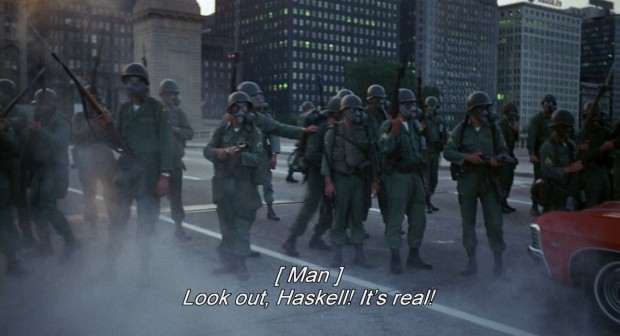An iconographic and text archive related to communication, technology and art.
☛ Medium Cool by Haskell Wexler, United-States, 1969, @ 1:39:41. IMDb.
In the feature film Medium Cool, the line “Look out Haskell, it’s real!” is yelled by a character which does not appear onscreen as law enforcement agents shoot a tear gas canister directly at the camera. At that moment, the forth wall which traditionally separates the audience from the fiction is briefly engulfed in white smoke (before the film cuts to another sequence). The sequence is neither the first nor the last one where the nature of the film appears to be shifting from a work of fiction to a documentary film.
The film was shot at the height of the Democratic National Convention protests in Chicago, in August 1968. Behind the camera was veteran cinematographer and documentary filmmaker Haskell Wexler, who had previously worked on Elia Kazan’s America, America (1963) and won an Oscar for Best Cinematography on Who’s Afraid of Virginia Woolf? (1966). In the summer of 1968, he was shooting what I believe was his first feature narrative project. The protests served as the main material for the last, climatic segment of the movie, partially based on the novel The Concrete Wilderness by Jack Couffer (although there is no protests in Couffer’s novel).
For the unique footage of the protests alone, the film is well worth watching. The way it is shot ―with a strange realistic quality one is not used to in fiction films― somehow reminded me of the cinema of John Cassavetes. I watched A Woman Under Influence recently and, like many others, I was shocked by the life-like quality of the film, the intimacy of the camera shots, the proximity one feels with the characters, sometimes to the point of uneasiness (like invading someone’s private life).
As it turns out, Haskell Wexler and John Cassavetes were good friends. Wexler had loaned Cassavetes equipment for the production of Faces (most of which was done in 1965, with some reshooting in 1967, before the film was released in 1968). He had also shot a five-minute sequence which was used in the general release version of the film (Wexler’s name, however, does not appear in the credits). When came the time to shoot Medium Cool, Wexler first offered Cassavetes the lead role (see Cassavetes on Cassavetes, London: Faber and Faber, 2001, pp. 141-142). Although Robert Forster finally got to play the role, the name of the character, “John Cassellis”, is said to be “a mash-up of John Cassavetes and drama teacher Milton Katselas” (see John Bailey’s excellent essay: “Medium Cool: To Preserve Disorder” July 1st, 2013).
Beside the segment about the protests in Chicago, the film is worth watching for many other reasons. From its take on mass media and spectacle to government surveillance, all the way through our relation to technology and the challenges posed by the many differences that bring us together (economic, ethnical, generational, etc.), the film tackles topics which are still highly relevant today.
In May 2013, The Criterion Collection released a restored 4K edition of Medium Cool on Blu-ray (the restoration was approved by Wexler). Among many things, the new edition includes excerpts from Paul Cronin’s highly interesting making-of documentary titled Look out Haskell, it’s real! A 55-minutes version was first release in 2001, but Cronin recently released another, much longer 360-minutes version. All those versions are available to watch online, at Vimeo.
In the 55-minutes version, Wexler explains how he was able to film the protest at close range, in an era where authorities had not yet become “picture wise, TV wise”. However, filming the protest at close range also involved some risks. For Wexler, it meant being tear-gassed: he is the one referred to in the line “Look out Haskell, it’s real!”. He talked about the experience in various interviews:
It was real and I was tear-gassed with Jonathan Haze my producer and friend. I don’t know if you have ever been tear-gassed, but particularly that CN gaz… when we think about tear gas, we think it will make you cry and uncomfortable… it [actually] makes you think you’re gonna die, because you can’t breath and your skin burns like hell.
Wexler then goes on to supply a surprising bit of information about the famous comment yelled offscreen:
I have to tell you that the line “Look out Haskell, it’s real!” was done afterwords. I put it in. Because we were not shooting sounds [at the time]. But it was my intention and it was on my mind. If someone read my mind at the moment I was shooting and the fucking tear gas was coming at me in slow motion… something in me said those very words. […] When you’re looking through the camera, in a sense you’re not there: you are looking at the movie you’re trying to make. When the tear gas came at me, it was a strong enough jab from the so-called real world to remind me that that ground glass with the etched 1.85 is no barrier to your lungs, to your eyes, to your face.
As for the reference to Marshall McLuhan’s “hot / cool” taxonomy:
The name [Medium Cool] came from the suggestion of one of the actors. I had read some Marshall McLuhan and couldn’t understand him. And when people later asked me about the meaning of “Medium Cool”, the name and the title of the film and Marshall McLuhan, I refer them to the library to see if they could figure out what the hell he was talking about.
There is much more to learn both about the film Medium Cool and the making-of documentary Look out Haskell, it’s real! over at The Sticking Place: see especially the “Introduction”.
- By Philippe Theophanidis
- on
- ― Published in Art, Communication, Movies
- Tagged: documentary, fiction, Haskell Wexler, media, medium, protest, reality, tear gas, United-States

